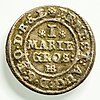|
Mariengroschen
1 Mariengroschen, Principality of Calenberg, John Frederick, undated, (Welter 1812) 1 Mariengroschen, Principality of Calenberg, Ernest Augustus, 1683 (Welter 2027) The Mariengroschen ("St. Mary's groschen") is an historical coin that was a type of groschen minted in Lower Saxony and Westphalia from the 16th to the 19th century. It was named after the Virgin Mary who was depicted on the reverse side.[1] Mariengroschen were first minted in Goslar in 1505 and then in other mints in the Harz mountain region, such as Brunswick and Hildesheim. The first coins were made of 8-lot silver; 80 being struck from 1 gross Cologne Mark. The fine weight decreased in the course of the 16th century;[2] already around 1550 the fineness had been reduced to about half:[1]
The knightly estates of the Lower Saxon Circle, which were entrusted with coin supervision, followed this development. The Meissen Groschen gained influence through the debasement of the Mariengroschen.[3] Late Mariengroschen3 Mariengroschen Royal Hanoverian Convention coin, 1818 (Welter 2849) In the Kingdom of Hanover Mariengroschen were last minted in 1816-1820 as Convention coins;[4] the Duchy of Brunswick minted the Mariengroschen at five lots until 1834; Schaumburg-Lippe until 1821 with 1/4 fineness.[1] References
External linksWikimedia Commons has media related to Mariengroschen. |
Portal di Ensiklopedia Dunia





